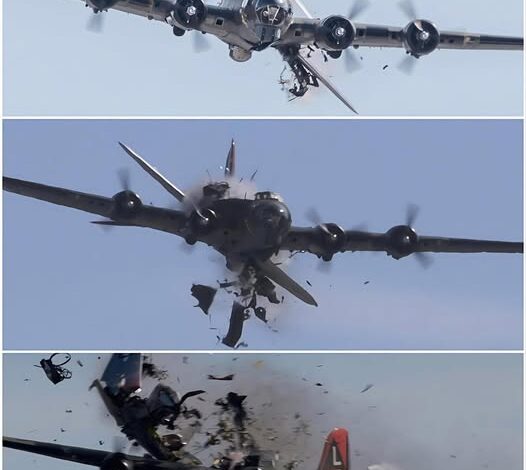Dallas Air Show Tragedy: B-17 Flying Fortress and P-63 Kingcobra Crash During Mid-Air Collision

In November 2022, a routine air show in Dallas turned into a scene of unimaginable tragedy. Spectators who had gathered to celebrate aviation history were suddenly confronted with a catastrophic accident involving two World War II-era aircraft: a B-17 Flying Fortress and a P-63 Kingcobra. What was intended as a commemorative flight honoring America’s rich aviation heritage ended in disaster, claiming the lives of all crew members on both planes and leaving the crowd in shock.
The Aircraft Involved
The B-17 Flying Fortress is one of the most recognizable bombers from World War II, celebrated for its durability, firepower, and the critical role it played in the Allied campaign over Europe. Known affectionately as the “Flying Fortress,” the B-17 became a symbol of American ingenuity and resilience during the war.
The P-63 Kingcobra, though less widely known than the B-17, is a rare fighter aircraft developed by Bell Aircraft. With its sleek design and impressive speed, the Kingcobra represented the cutting-edge technology of its time. Both planes were meticulously restored and maintained by enthusiasts, allowing modern audiences to witness history firsthand during Heritage Flight demonstrations.
The Heritage Flight Demonstration
Heritage Flight demonstrations are designed to honor America’s aviation legacy. These displays feature vintage aircraft flying in formation, often accompanied by modern military jets, creating a powerful visual tribute to the pilots and aircraft of past wars.
On that fateful day in Dallas, the B-17 and P-63 were participating in one such demonstration. Thousands of spectators, including families, veterans, and aviation enthusiasts, gathered to experience the spectacle. The air was filled with excitement and anticipation as the historic aircraft performed maneuvers in coordinated flight.
The Mid-Air Collision
Tragedy struck when the P-63 Kingcobra accidentally collided with the B-17 Flying Fortress. Witnesses described the moment as a scene from a nightmare: the two planes made contact, sparks flew, and both aircraft began to spiral out of control. Within seconds, the collision turned catastrophic.
The B-17, heavily damaged by the impact, plummeted toward the ground, trailing smoke and debris. Simultaneously, the P-63 caught fire, adding to the chaos. Onlookers below watched in horror as parts of both planes rained down, a stark and terrifying reminder of the risks involved in operating historic aircraft.
The crash instantly claimed the lives of all crew members aboard both planes. The loss was deeply felt within the aviation community and among those who had gathered to honor the history of these remarkable machines.
Witness Accounts
Spectators at the air show described the collision as shocking and surreal. Some recounted hearing the deafening sound of metal striking metal, followed by a roar as flames engulfed the aircraft. Others shared the sight of debris falling from the sky, scattering across the field where families had gathered.
Veterans who were in attendance spoke of the emotional impact of witnessing such a tragedy. Many had flown or worked with similar aircraft and understood both the technical challenges and the inherent dangers involved. Their reaction was a mix of grief for the lost crew members and concern for the spectators who had witnessed the accident.
Emergency Response
Emergency crews acted quickly in the aftermath of the crash. Firefighters and paramedics rushed to the scene to contain fires and assess the situation. Despite their rapid response, there were no survivors. The tragedy highlighted both the bravery and limitations of emergency responders when dealing with high-impact aviation accidents.
Authorities cordoned off the crash site to ensure safety and begin investigations. Teams of investigators from the Federal Aviation Administration (FAA) and the National Transportation Safety Board (NTSB) were dispatched to examine the wreckage, interview witnesses, and determine the cause of the collision.